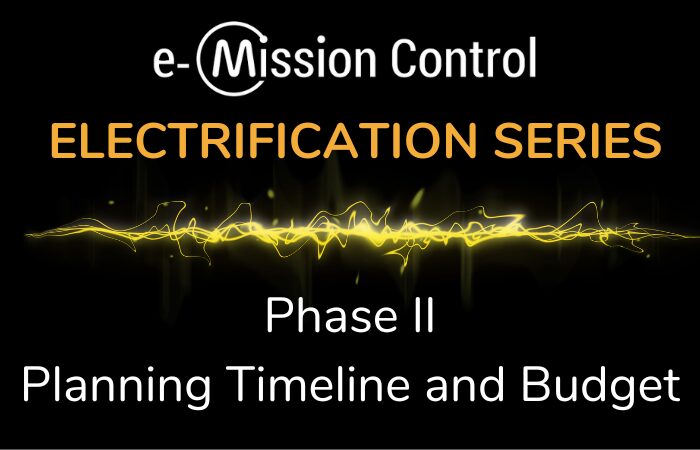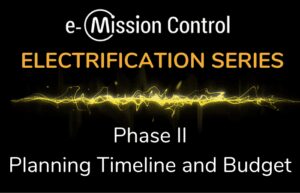

Tasked with electrification of your fleet? We’re here to help you with an electrification transition timeline. Once you’ve completed our Electrification Transition Phase 1: Pre-Planning and Organizational Buy-In, it’s time for the next “planning” phase which primarily revolves around budgeting and managing project expense expectations. This second planning phase is six steps and should take two to three months.
1. Find and apply for available funding and incentives
The cost of establishing an EV fleet can be a significant hurdle for many businesses and organizations. However, there are numerous funding and incentive programs available at the local, state, and federal levels that can help offset the cost of purchasing and installing charging infrastructure as well as buying electric vehicles.
Most commonly and most easily accessible, utilities will offer rebates for electric charger installation. For example, the Sacramento Municipal Utility District (SMUD) offers incentives for commercial vehicles including light-duty cars, trucks or semi-tractor. In addition, electric vehicle charging installations for customers, tenants or employees are eligible for incentives of $4,500 per handle for each level 2 EV charger.
As another example, in Oregon, through the Eugene Water & Electric Board (EWEB) Oregon’s largest customer-owned utility, new level 2 public charging stations for business, workplace, fleet, or multifamily housing site buildings (5 residence units or more) may qualify for a $1,500 rebate per station. New level 2 public charging stations for qualified multifamily affordable housing sites may be eligible for a $2,000 rebate per station.
Separately, there are myriads of other tax credits and rebates, incentive programs, and other benefits for going electric, and can be found in places like ElectricForAll, OpenGrants, and DriveClean. e-Mission Control also keeps an active repository of grant and funding opportunities on our website.
2. Determine budget using TCO
When electrification planning and determining your budget for your EV fleet, calculate total cost of ownership (TCO), which is a more important budget consideration than purchase price alone and considers long-term costs. TCO is the purchase price of the electric asset plus the cost to operate over the asset’s lifespan, which includes fuel and maintenance. While electric vehicles and equipment may have a higher purchase price than their traditional counterparts, the cost to operate them is usually lower. Fewer moving parts in electric engines generally means fewer components to fail and less maintenance. By looking beyond the purchase price, TCO can help companies make more informed purchasing decisions and develop a more accurate budget that accounts for costs over time.
3. Set a timeline for implementation
Your implementation timeline can be tricky as you are depending on factors such as your utility to provide energy and original equipment manufacturers (OEMs) to supply infrastructure. Organizations should consider factors such as available funding, the procurement process for purchasing EVs and charging infrastructure, and the availability of installation contractors. Establishing a realistic timeline for implementation can help ensure that the project stays on track and is completed on time and within budget.
4. Select a location for your chargers
If you select your charger location on a pleasant, sunny day you may have overlooked the fact that charging may also occur at night and in the rain. Be sure to consider lighting, weather protection, and ADA access when establishing a charging location so that you can maximize utility and avoid having to relocate your chargers.
5. Determine if you will share your fleet charging with other users
Organizations must decide whether they will share their charging infrastructure with other EV users when electrification planning. Sharing your EV chargers can reduce the cost of installing and maintaining them, but may create conflict over availability. Discuss long-term schedule predictions and hours of use before agreeing to share chargers with another entity. If you have opted for depot charging, understand clearly when the chargers will be available to you.
6. Select hardware (what vehicles and chargers will you buy)
Shopping for vehicles and equipment can be fun, as there is an increasing selection available. When choosing an electric vehicle, consider what factors are in play when calculating electric truck range. Ahead of your purchase, know how many miles you drive each day and make sure your electric truck’s range is much higher than that. Keep in mind that there is no industry standard on how to measure vehicle range, so an OEM may be stating “ideal” numbers rather than real-world range figures. Make sure to ask your sales rep how they’re calculated so you know that the range estimate is possible with your routes.
Do you need DC fast charging? DC fast charging uses a high-voltage direct current (DC) to rapidly charge the electric truck’s battery. These chargers are typically found at public charging stations and can charge a truck’s battery to 80% in around one hour.
An alternative to DC fast charging is level 2 charging. Level 2 charging uses a 240-volt electrical outlet. These chargers are typically fixed and can be installed at a trucking company’s depot or at a public charging station. Level 2 charging can typically charge a truck’s battery to 80% in around four hours.
DC fast charging is generally more expensive and requires a higher level of technical expertise to install and maintain than level 2 charging. However, the cost of using DC fast charging for a truck may be worth it, especially for long-distance hauling. The faster charging time of DC charging means that drivers can get back on the road more quickly, allowing them to make more trips in a given period of time.
In our next blog on electrification planning, we will cover Phase 3: implementation and Phase 4: Results, Evaluation, and Iteration.